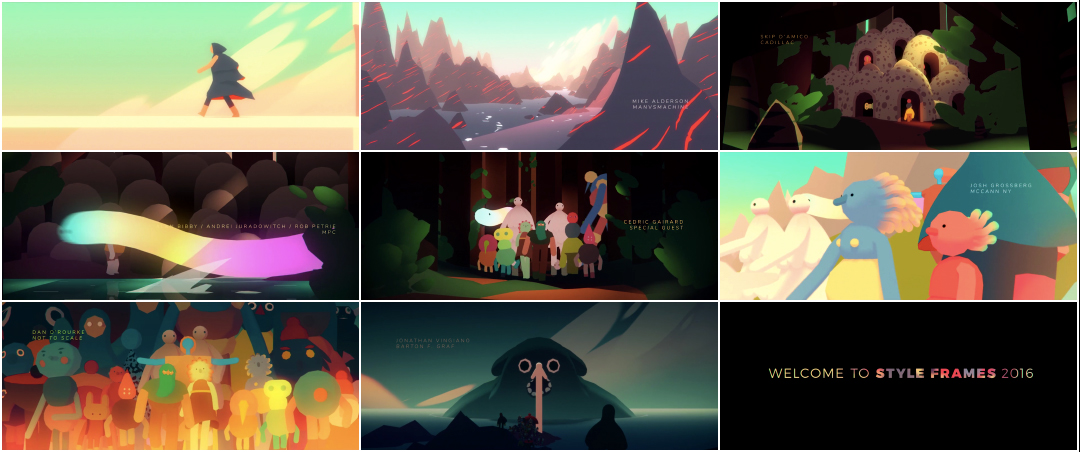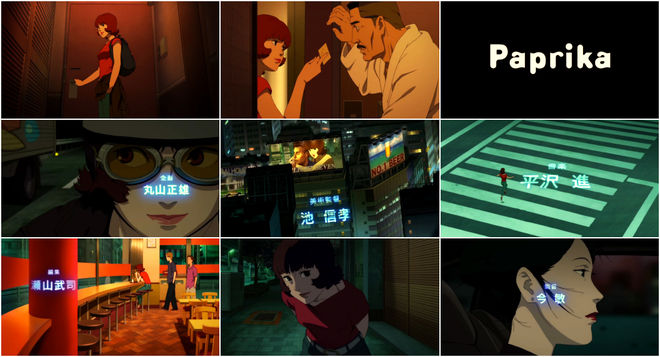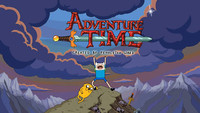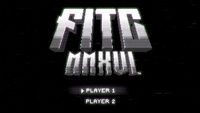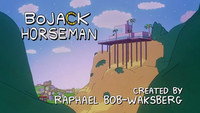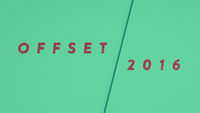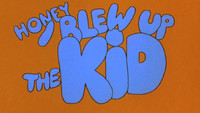In the magical and surreal worlds formed by animator and artist Eran Hilleli, creatures great and small come together through a connection with their strange surroundings, blurring the lines between person and place and experiencing epic journeys.
In Hilleli’s animated title sequence for Style Frames 2016, a creative conference that took place in New York City in early November, a lone, cloaked figure steps out onto a narrow bridge and walks confidently toward an enormous bugle. The figure breathes deeply and then sounds the horn, which rings out across landscapes of striped crags, fields of canary yellow grass and pale pink stones, penetrating into the depths of the forest. Various creatures emerge from holes and trees and ovoid homes, silently slotting themselves alongside each other. They have been called, and they will come. They walk together, bearded and hoofed, mottled and glowing, lumbering and hopping, a gorgeous ragtag group traversing forest and desert and valley and growing as they go. The music by Disasterpeace, rising slowly toward a calm crescendo, infuses the scenes with grandeur and serenity. They reach the sea, the edge of the land, and watch as an immense creature rises from the water. Its mouth is gaping and its eyes are wide. It dwarfs the mountains, placing everything in shadow, and suddenly the situation seems dire. In a flash, the lightness returns. The bugle becomes a projector, and the creature’s chest a screen. It smiles, a sense of relief washing over it as various shapes flicker in the light. Back on the shore, the creatures cheer. They, and the conference audience, have come together willingly and with purpose, looking for inspiration and answering the call.
A discussion with Animator and Director ERAN HILLELI.
Give us a little background on yourself. How did you start out?
Eran: I went to school in Jerusalem, at the Bezalel Academy of Art and Design. I studied animation there for four years and on the fourth year there, you kind of dedicate it to your thesis film so I made my short film called Between Bears.
Between Bears (2010) short film by Eran Hilleli
Eran: Since then, like straight after uni, I got signed by XYZ, an animation studio in Australia and started being represented as an animation director and working on projects like commercials and music videos. In parallel I kept working on my personal projects and after a few things I got represented by Hornet Film in New York as well. Now I’m kind of with both studios, working on things that come up.
Between Bears is really lovely. That got you quite a bit of attention, right?
Eran: Thank you! Yeah. Luckily, it did. It was kind of my first step into this world so I was a bit naive. I wasn’t dreaming of being a director or anything. I just wanted to make animation films and design characters… through that film I got a lot of opportunities. It was also part of the Vimeo Festival. It won the Best Animation Award which got me far more attention. It was very surprising. That was 2010 when I finished the film. Then 2011 was when stuff started happening.
Music video for "Boys Latin" by Panda Bear by production company Ghost Robot, NY. Directed by Isaiah Saxon and Sean Hellfritsch with animation directed by Eran Hilleli.
So how did this project come to you, for Style Frames 2016?
Eran: It was Steven Price from Stash – you know, Stash Magazine? – I was a big fan of Stash from early days. As a student they featured some of my films. I was really in debt to them for supporting my student work. He contacted Michael Feder from Hornet and offered Hornet to make the opening titles for the festival. Hornet thought of me for this. I just had – like, my wife had our first baby just a month before. I was kind of in off-time in the commercial world, I didn’t want to take any jobs, so they figured this could work. It seemed perfect for me to kind of refresh my personal portfolio outside of the commercial world. I was a little bit scared in the beginning but I jumped on it!
What made you hesitate?
Eran: It was practical life things. I wanted to be there for raising our baby. You know, I’ve been used to, all my life, having as much time as I needed for work and suddenly another element was introduced to my time. But I just jumped in and started figuring it out. Time was the biggest challenge, I would say.
How did you develop the narrative for this piece?
Eran: After speaking with Steven we both agreed that we’ve seen a lot of festival titles – it’s kind of like a subgenre – and that the more interesting ones were ones that weren’t just eye candy. They had some narrative to them. I wanted a very slim narrative, something to tie all the shots. The two things I like to do the most are characters and landscapes, creating worlds and atmosphere, so I started imagining how cool it would be having this title piece focus on characters coming together in all sorts of places, all different types, and kind of tie it up together with a small narrative. I had this rough plan in mind and I started working pretty roughly and things just kind of settled into place.
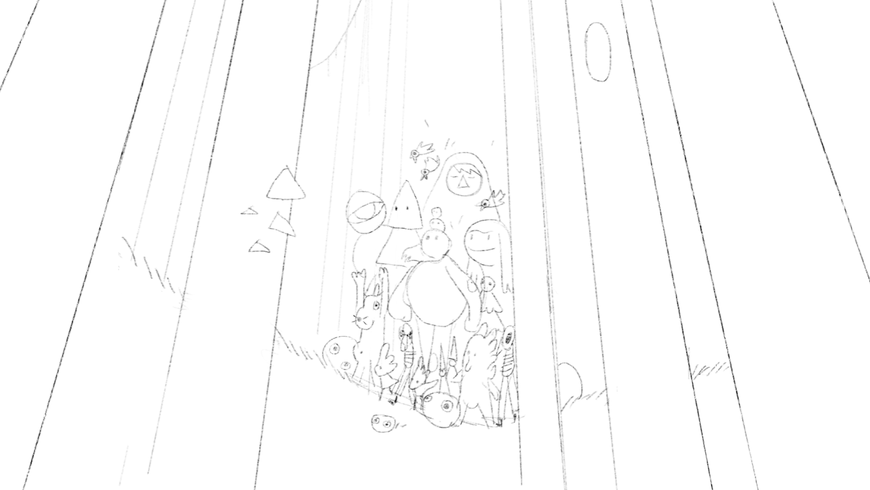
Sketch of characters emerging from forest
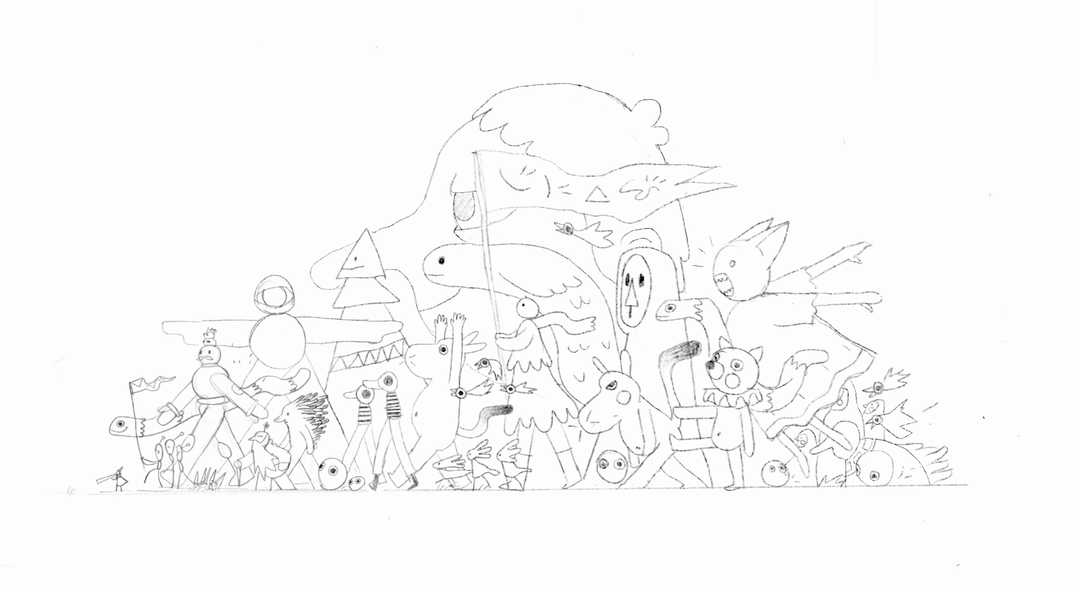
Sketch by Eran Hilleli of the characters walking together.
Did you create storyboards?
Eran: I didn’t make boards. First I made some motion tests just to figure out how I can deal with so many characters and I looked for technical solutions to do it. I was working almost by myself, and instead of boards I jumped into 3D software, which I’m pretty comfortable in, and I just started roughing out the whole piece in black and white and rough shapes. Just so I can test, you know, the camera and the cuts already instead of doing boards and scanning them and an animatic and all that.
Style Frames 2016 title sequence previz
Eran: When I work with a team on commercial deadlines you have to use boards to communicate your ideas but I was communicating with myself mainly, so I was free to pass on to advanced stages from the beginning. The motif of the calling – the big horn in the beginning – I knew that would be a good start.
The motif of the calling — the big horn in the beginning — I knew that would be a good start.
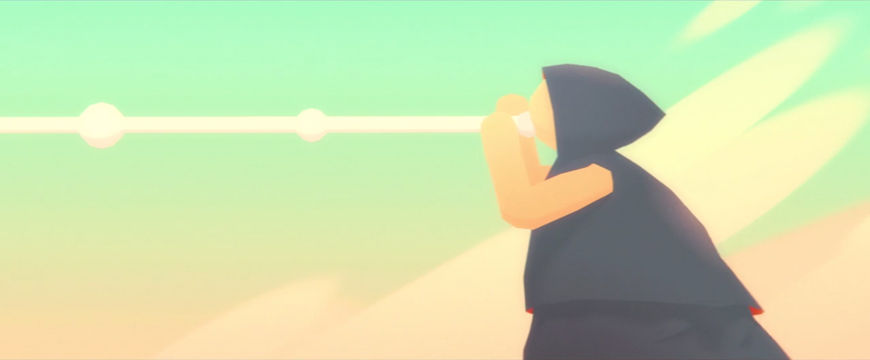
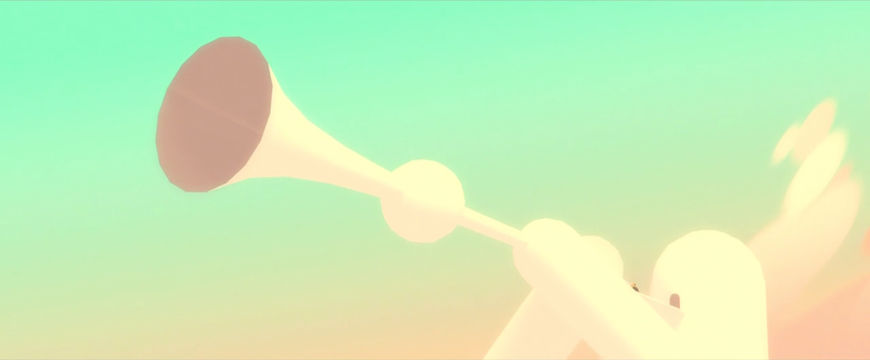
Eran: I wanted it to feel like a journey but I didn’t want to get too serious or too epic, so that’s where the end bit came into play. Looking for something to break it, to make it a little bit on the humour side, make it lighter at the end. Not try to portray something too philosophical or too big, which I think Between Bears was. There was an open end to let people figure out whatever they want to figure out from the piece. This time I wanted to make it lighter and more definite.
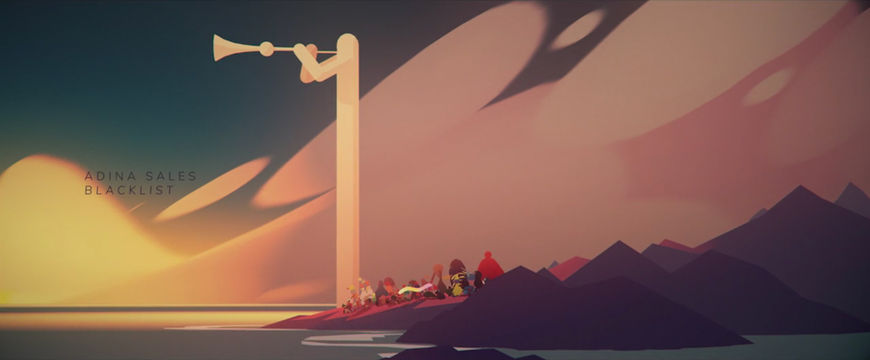

So you jumped into the 3D pretty early. Which software were you using?
Eran: In 3D, I work with Maxon Cinema 4D. When I do stuff alone, I would always choose that. I do have to always maintain some knowledge in Maya because when I work with teams, usually the animators are in Maya. This piece was 99% in Cinema 4D, but I still had to make a few characters work in Maya because I had some support from an animator friend that works in Maya. The rest was composited in After Effects!
Style Frames 2016 title sequence animation test
Eran: Another note on the software side: I found out in the beginning of the project about Adobe Mixamo. Adobe bought this company called Mixamo that was there for quite a while but because I’m a CC user suddenly I had this Mixamo thing available already. It’s kind of a quick rigger kind of thing; it rigs the character and then you have options for animation and motion capture.
The thought of solidarity of characters joining up together and walking has such a big effect on my daydreams
So playing around with it on the first few days it was a shock as to how quick I can rig a character and put some basic walk cycles on it. That was really reassuring to help with the production. I used that quite a lot. I invented a small workflow for myself. You kind of start from a readymade thing and I tweak it for my needs. The feel of the characters all being so minimal and coupled with pretty realistic movement was something that I was very happy with. The contrast of such minimal characters moving so lifelike was very appealing for me. Mixamo played a big part in it!
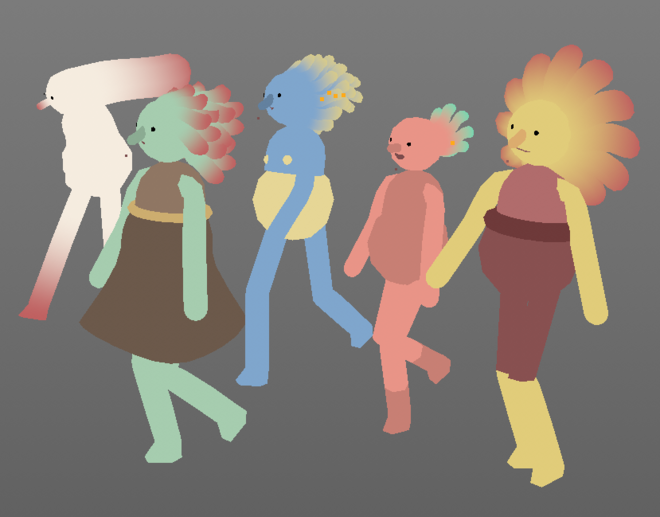
Early character renderings
There are some similarities between this piece and your film Between Bears. Both short pieces begin with a couple of small characters, who are then joined by others, and then there’s this big group that are on a huge quest all together...
Eran: Yeah! I guess it’s a very strong narrative thing that I keep coming back to. You know, in the beginning of the project I kind of developed this without even thinking too much. Then I quickly realized that, “Oh, shit… is that..?” I was kind of interested in giving it another go and seeing where this leads. Definitely there are similarities. I hope there are enough differences in there!
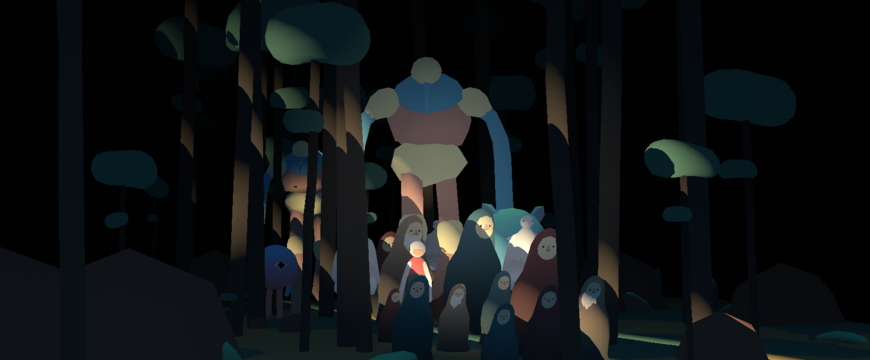
Still from an early version featuring characters emerging from the forest.
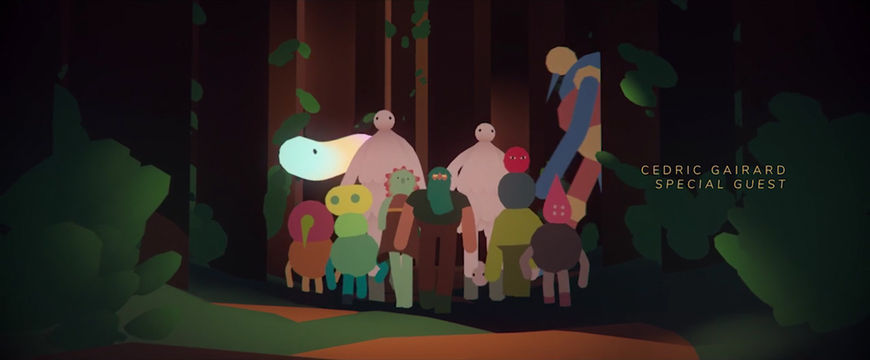
Still from the final sequence featuring characters emerging from the forest.

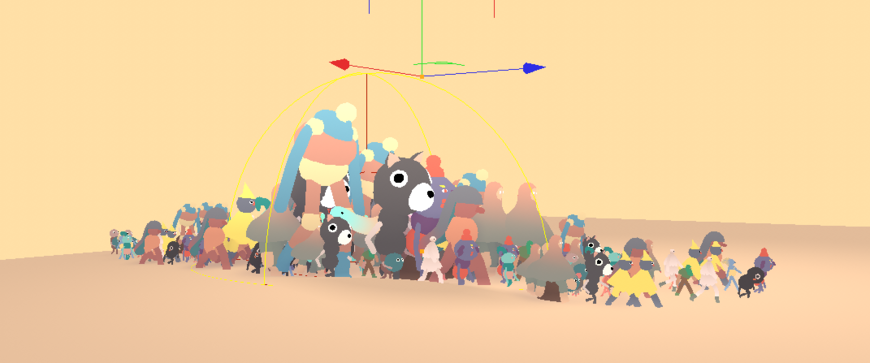
Screenshots from early arrangements of the group of characters.
Eran: Maybe it’s films like Paprika, which was such a huge influence while I was studying animation. The thought of solidarity of characters joining up together and walking has such a big effect on my daydreams and stuff that I can probably keep doing this many times. Whatever gets you going that gets you to make something is a stronger motivation than trying to be different.
Paprika (2006) main title sequence
Eran: But I did take the chance to explore it further and make far more characters and different characters. Even though it’s still minimal 3D, it’s different and more detailed. Between Bears had very strict rules in design and straight lines. Even in the design language, I would try to have these rules like working only with these kind of lines and everything has to be like this and like that. Being afraid to make a mistake. The group of characters there was variations on the same monk-like character. Working on these things can be very complicated and take you out of the actual pure thing. This time I allowed myself to play more, with more freedom.
I’m understanding what’s more important. I’m not so anal about rules, and suddenly I break the rules all the time

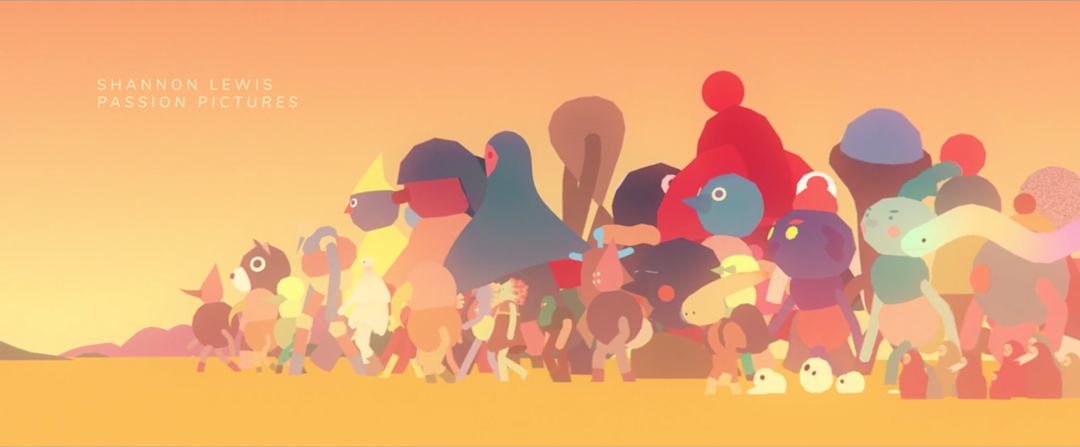

Stills from the final sequence featuring the group of characters walking together.
Eran: I’m getting more fluid in it and it’s becoming just tools – especially in Cinema 4D – and I feel like I’m almost with a brush and canvas. That gives me that ability to improvise and have fun while I’m working and not just chase little goals and bang myself on the computer and get stuck. I’m embracing limitations and I’m understanding what’s more important. I’m not so anal about rules, and suddenly I break the rules all the time and when I look at it – especially through my friends’ eyes – I see it as a whole. I’m starting to see that.
It definitely shows a creative growth. The characters are more various, there’s more types. Both groups kind of meet a strange creature in the water...
Eran: [laughs] Yeah, I guess so! Ending on the water is something I find a lot of films do. I wonder… It’s an interesting thing. That motif of ending films on the coastline. I’m born and raised in Israel, I’ve been growing up on the beach and spending time there, not just happy summer days but even in winter. Just going by yourself and sitting on a cliff or something. There’s something just spectacular about it. Sometimes I kinda go on to a bird’s-eye view and watch the shore from above and look at it from an alien point of view. We’re all like tiny, tiny creatures and we tend to go and visit the edges of our land and just kind of be there. It’s just a beautiful thing, you know? You don’t go there to consume anything. There’s no materialistic reward or anything, we just go there to kind of be. I find it soothing.
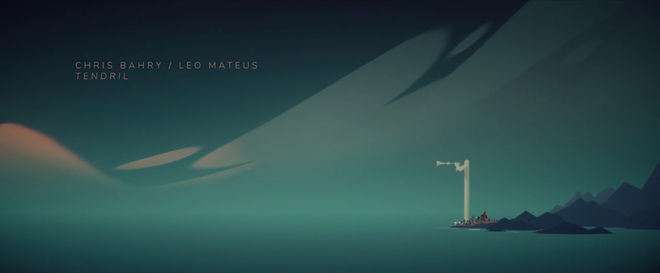
How did you work with Disasterpeace for the music and the sound?
Eran: We hooked up through social media, just following each other’s work. We’re in different continents so we worked through the Internet. We have this Slack channel thing – you know Slack, collaboration tool? – and I wrote just random things, what I like and how I see some things, and he wrote back and we slowly calibrated. We iterated, ping-pong style. He sent stuff, I commented – just a good, healthy discussion. I really really like his work, I like everything he does and it was a really great experience. I’m really happy with the music. They’re always saying sound in animation is 51% of the impact. It’s just so powerful in how it delivers the whole thing. It gives it this emotional side. Just the right amount to make this thing communicate some emotion.
You mentioned Paprika. What inspires you, film-wise or animation-wise? Do you have things you watched as a child that you still think about when you’re working?
Eran: I must say, childhood stuff is really, really strong in my mind. I guess because it’s from stages of life where I was not criticizing anything. I was just in that place of wonder and awe and I wasn’t analysing things. It was pure. Everything was pure. It was the ’80s so it was a lot of Japanese series. There was Moomin, which is Tove Jansson’s Scandinavian tale of the Moomin family, which is maybe the biggest influence of my childhood. Again, a Japanese studio.
Moomin (1990) main title sequence from the English version (Season 1, Episode 1)
Moomins are a huge influence because the tone there, it’s kind of for kids ’cause it’s a cartoon thing but it’s so not straightforward. It’s all mixed with eerie things.
The Moomins are kind of amazing, because they’re all these different creatures all living together in this kind of bohemian utopia.
Eran: Right! [laughs] Exactly. It’s like humans and animals and all sorts and magic and not magic. Simple things about communication between them and glorious fantastic tales, but all very underplayed. It’s not like epic more American kind of art… I don’t want to diss American cartoons here but it’s just a different tone.
Also Mysterious Cities of Gold which is kind of Inca stuff… These things really shaped my brain and my visual mind.
The Mysterious Cities of Gold (1982) main title sequence
Eran: Then I grew up and realized, oh, this is all Japanese studios! So I started investigating that more. I found out about more contemporary stuff like Studio 4°C which is amazing, stuff like Genius Party, and more like artful kind of anime style. Directors like Masaaki Yuasa.
Masaaki Yuasa directed the animated short film Happy Machine, number six in the Genius Party series.
These things really blew me away and that really influenced my line. I was studying drawn animation and I started copying stuff from there and trying to develop my style that way. I was always into combining aesthetics of Japanese animation and French illustration. Narrative-wise I was always trying to go for the sparse narrative, more open-ended, more poetic stuff. Not necessarily action-based. I like it more subtle and more weird and more open-ended.
What are your personal favourite title sequences?
Eran: I really, really always liked Studio Ghibli stuff. Like Totoro’s titles or Ponyo’s titles.
My Neighbor Totoro (1988) main title sequence
Eran: I really love how they kinda take that section of the film to give a different aspect of the story, even inventing this different graphic style for it. It’s all very simplified, almost graphic, more childlike. They kinda have fun with it and with the text. I find it really beautiful. Totoro and Ponyo I remember specifically. It has this very optimistic kind of feeling and simplified graphics.
Ponyo (2008) main title sequence
And what’s next for you? What are you working on for the future?
Eran: I’m not sure! I’m considering a few projects. I’m trying to decide if I’m going to dive into VR. I do have a few games that I worked on in the past in my spare time. But it’s pretty hard thing, finishing a game, I realized in the last year! I really want to do that. Small games that are not necessarily goal driven, but more like interactive pieces that you can walk around with a character and kinda just feel the world and meet characters. Somewhere in between a short film and an interactive thing that are open-ended like my short films.
As soon I saw your work, I thought, “This person should make a video game.”
Eran: [laughs] A lot of people have told me that! It is just such a hard medium. It’s so easy in the beginning, but really finishing a thing is so much harder than it sounds! It’s crazy, it blows your mind. But I really love it so I’m really looking forward.

